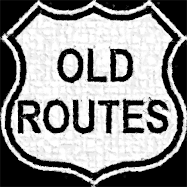Resolved, that Dr. Franklin, Mr. J. Adams and Mr. Jefferson, be a committee, to bring in a device for a seal for the United States of America.
It wasn’t until 1782 that they came up with the final version of the seal. It has changed slightly over the years. You probably may and handle it every day as both sides of the seal are on the back of the US One Dollar Bill.
The US Route Shield was modeled after the shield in front of the eagle. Some earlier versions of the seal shield look even closer to the route shield shape.
Part of the logic of the new roads was to have a national numbering system that was consistent state to state, and as part of that the signs should be of similar shape and standards as well.
Along with the numbered shields, there were also smaller shields with only an “L” or “R” noting which way to turn at an intersection to stay on the route.
When they first start posting the US Routes in the 1920’s there were very little signage even noting road names or even where they went. When Dr. Horatio Nelson Jackson and his his co-driver Sewall K. Crocker, went on the first coast-to-coast road trip in 1903, even when they had a road to drive on, they spent much of their time lost going down the wrong roads.
For State Highways, there are all sorts of versions. A common one is the use of the shape of the state or the state seal as the outline.
Less creative is the use of geometric shapes like a square or circle.
Some overhead intersection signs in the Portland suburb city of Tigard, Oregon were recently
 changed on old US99W. This is now state highway 99W. I noticed it wasn’t the state shape, but it wasn't the US Shield either. They used a fully white Interstate Highway shield. Well, I think someone had a nice historical thought anyway. *
changed on old US99W. This is now state highway 99W. I noticed it wasn’t the state shape, but it wasn't the US Shield either. They used a fully white Interstate Highway shield. Well, I think someone had a nice historical thought anyway. *We have t-shirts, hats and other "shielded" items an our Old Route Souvenir Shop.
If you know where an actual old US Route shield remains on a former or decommissioned US Route, please write me at OldRoutes@gmail.com.
If you want to know even more, check out http://www.us-highways.com/ussign.htm from Robert V. Droz.
See all the State Route Shields at http://en.wikipedia.org/wiki/Wikipedia:WikiProject_U.S._Roads/Shields/Database
Get your own realistic US Route Sign.
*99W sign in Tigard Oregon, Copyright 2008 Dan Smith

